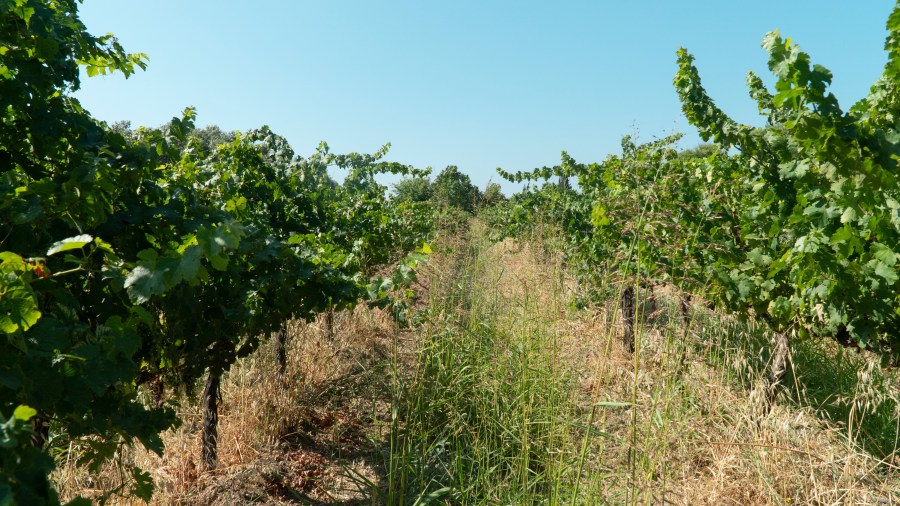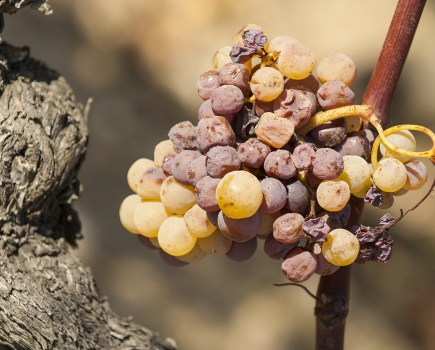As spring kicks vines into action, inevitably so does weed growth. Hutchinsons agronomists Rob Saunders and Chris Cooper consider some of the weed control options available.
Maintaining a weed-free strip immediately around and underneath vines offers multiple benefits for reducing competition with the crop, and facilitating free air movement for reduced disease pressure, especially botrytis during ripening later in the season.
Doing so sustainably is an increasing consideration for many growers, but it is not easy to assess and compare traditional herbicides with non-chemical solutions based on cultivations, or novel kit that uses electric, gas burners, or high pressure water or steam, to control weeds. The energy requirements, time, and financial outlay must all be considered, as well as the impact of tillage on soil health.
Cultivations for example, can be very effective in the right conditions (i.e. dry, friable soil), however in wet soils, or on heavier ground it may be much harder to get right. Moving the topsoil on a regular basis raises other concerns too, such as erosion on sloping land, carbon losses, and the impact on biodiversity, such as ground-nesting bees and soil biology.
Living mulches
Although not widely used yet, there is increasing interest in sowing green covers underneath vines to suppress weeds, improve soil health, and benefit biodiversity. They also offer an added aesthetic factor, which may be important to those who open vineyards for public events or tourism.
It is vital that any species sown underneath vines do not grow too tall or vigorously, to minimise competition, allow good airflow around vines, and facilitate bunch ripening later in the season.
Viticulture researcher Michela Centinari identified Red fescue as a useful option, most applicable where excess vine vigour is a problem. It can be tricky to establish though, as it is not particularly competitive when small, so higher seed rates are required.
Microclover is another option Hutchinsons is looking at in a small trial with one grower in the West. The plant’s short, stunted growth habit is ideal, while it also fixes some atmospheric nitrogen into the soil.
Living mulches have the added benefit of shading the soil, reducing soil temperatures in extreme summer heat, to the benefit of soil organisms and reduced vine stress. With any living mulch, there remains the risk that dominant weeds, such as thistle, will come through, and chemical controls are then very limited due to the risk of killing cover. It may be possible to use a weed wiper for taller species, or deploy an inter-vine mower.
As with any green cover growing beneath vines, whether that’s microclover, Red fescue, or any other cover crop, initial signs can be promising, but only time will tell if there is any impact on disease risk, frost damage, ripening, vine vigour or yield.
Herbicides
While non-chemical options have a place in certain situations, in established vineyards, the traditional herbicide-based approach is still most effective, requiring only limited passes, and allowing soil to remain undisturbed.
Programmes should be tailored to the weed species and pressure at individual sites, but generally, glyphosate remains an important tool in the armoury.
On established sites under high weed pressure, some will have applied propyzamide to manage weed populations during the winter, which can be followed in late April or early May with glyphosate or carfentrazone-ethyl + glyphosate.
A second application of carfentrazone-ethyl + glyphosate later in the season is an effective approach in many situations, although remember that carfentrazone-ethyl has a 90-day harvest interval, so should be applied by the end of flowering.
Competition for light, water and nutrients is inevitably greatest – and potentially most damaging – on newly planted vines, so it is essential to control weeds properly before planting, and during establishment. Biodegradable membranes and hand-weeding planting holes are important options given limited chemistry.
Organic mulches
Applying organic material, such as PAS 100 compost, or woodchips, can help suppress weeds, while building soil organic matter and nutrients, but neither option offers a complete solution.
Weed seedlings often germinate within compost, for example, potentially increasing, rather than decreasing, the burden. Sourcing, transport and application of compost, can also be barriers to its use, while quality can vary.
Woodchips are an alternative mulch, potentially offering better weed control, but there are similar issues with availability, transport and application, due to their bulky nature. Additionally, the high carbon content of wood or bark chippings may reduce nitrogen availability to vines as woody material breaks down.
For more like this, sign up for the FREE Vineyard newsletter here and receive all the latest viticulture news, reviews and insight




